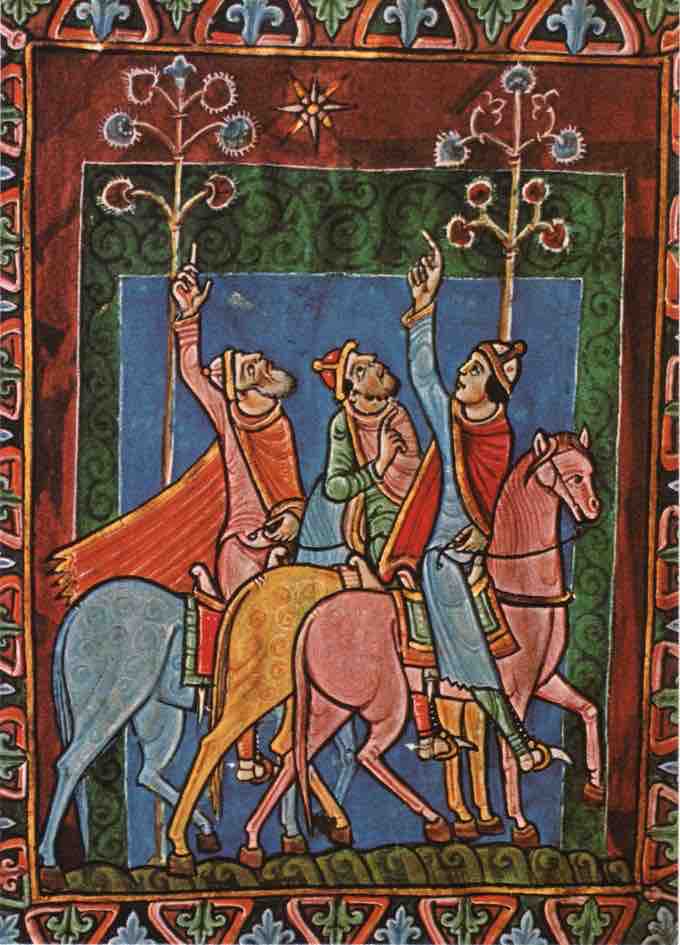Background: The Normans
The Normans were descendants from Norse raiders from Denmark, Iceland, and Norway who in the 10th and 11th centuries gave their name to Normandy, a region in northern France. The distinct cultural and ethnic identity of the Normans emerged initially in the first half of the 10th century, and it continued to evolve over the succeeding centuries. The Norman dynasty had a major political, cultural and military impact on medieval Europe. Norman cultural and military influence spread from France south to Italy and north into England after the Norman invasion of England in 1066.
Manuscript Illumination
In the visual arts, the Normans did not have the rich and distinctive traditions of the cultures they conquered. However, in the early 11th century, the dukes began a program of church reform, encouraging the Cluniac reform of monasteries and patronizing intellectual pursuits, especially the proliferation of scriptoria and the reconstitution of a compilation of lost illuminated manuscripts. The chief monasteries taking part in this "renaissance" of Norman art and scholarship were Mont-Saint-Michel, Fécamp, Jumièges, Bec, Saint-Ouen, Saint-Evroul, and Saint-Wandrille. These centers were in contact with the so-called "Winchester school", which channeled a pure Carolingian artistic tradition to Normandy. From roughly 1090-1110, Normandy experienced a brief golden age of illustrated manuscripts; however, the major scriptoria of Normandy ceased to function after the midpoint of the 12th century.
An illuminated manuscript is a manuscript in which the text is supplemented by the addition of decoration, such as decorated initials, borders (marginalia), and miniature illustrations. The typical foci of Romanesque illuminations were the Bible and the Psalter. Each book of the Bible was prefaced by a large historiated initial; major initials were similarly illuminated in the Psalter. In both cases, more lavish examples might have cycles of scenes in fully illuminated pages, sometimes with several scenes per page in compartments. The Bibles, in particular, often had a very large page size and might be bound into more than one volume.

Illuminated Manuscript, The Three Magi from the St. Albans Psalter, Norman English, 12th century.
The typical foci of Romanesque illumination, such as this one pictured, were the Bible and the Psalter.
Wall Painting
The large wall surfaces and plain, curving vaults of the Romanesque period lent themselves well to mural decoration in Normandy and other Norman lands. Unfortunately, many of these early wall paintings have been destroyed by dampness over the years, or the walls themselves have been re-plastered and painted over. In Normandy, such pictures were systematically destroyed or whitewashed in bouts of iconoclasm during the Reformation.
A classic scheme for the full painted decoration of a church had, as its focal point in the semi-dome of the apse, Christ in Majesty or Christ the Redeemer enthroned within a mandorla and framed by the four winged beasts (symbols of the Four Evangelists). If the Virgin Mary was the dedicatee of the church, she might replace Christ here. On the apse walls below would be saints and apostles, perhaps including narrative scenes. On the sanctuary arch were figures of apostles, prophets or the 24 "elders of the Apocalypse", looking in towards a bust of Christ or his symbol, the Lamb, at the top of the arch. The north wall of the nave would contain narrative scenes from the Old Testament, while the south wall would contain scenes from the New Testament. On the rear west wall would be a Last Judgment, with an enthroned and judging Christ at the top.
One of the most intact schemes to exist is at Saint-Savin-sur-Gartempe in France. The long barrel vault of the nave provides an excellent surface for fresco and is decorated with scenes of the Old Testament. One of these shows a lively depiction of Noah's Ark, complete with a fearsome figurehead and numerous windows through which Noah and his family can be seen on the upper deck, birds on the middle deck, and pairs of animals on the lower deck. Another scene shows, with great vigor, the swamping of Pharaoh's army by the Red Sea. The scene extends to other parts of the church, with the martyrdom of the local saints shown in the crypt, and the Apocalypse in the narthex and Christ in Majesty. The range of colors employed is limited to light blue-green, yellow ochre, reddish brown, and black.
Stained Glass
Another significant Norman art form is that of stained glass. Most of the magnificent stained glass of France, including the famous windows of Chartres, date from the 13th century. Far fewer large windows remain intact from the 12th century. One such is the Crucifixion of Poitiers, a remarkable composition which rises through three stages: the lowest stage is a quatrefoil depicting the Martyrdom of St Peter; the largest central stage is dominated by the crucifixion; and the upper stage shows the Ascension of Christ in a mandorla. The figure of the crucified Christ already shows hints of the Gothic curve. Many detached fragments are in museums, and a window at Twycross Church in England is made up of important French panels rescued from the French Revolution. Glass was both expensive and fairly flexible in that era (in that it could be added to or re-arranged) and seems to have been often re-used when churches were rebuilt in the Gothic style.
Other Visual Arts
Many works of art have survived from this time period, mostly as church vestments. Norman Romanesque embroidery is best known from the Bayeux Tapestry, an embroidered cloth nearly 70 meters (230 feet) long which depicts the events leading up to the Norman conquest of England. Images in the cloth include depictions of William, Duke of Normandy; the coronation and death of the English King Harold; the Battle of Hastings; and even Halley's Comet.

Bayeux Tapestry
The Bayeux Tapestry is an embroidered cloth—not an actual tapestry—which depicts the events leading up to the Norman conquest of England concerning William, Duke of Normandy and Harold, Earl of Wessex, later King of England, and culminating in the Battle of Hastings.